March 12, 1981
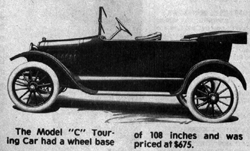
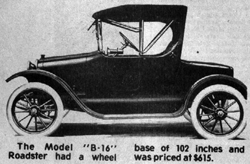
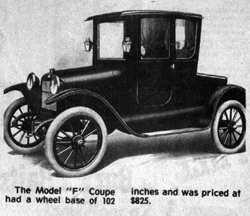
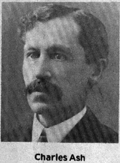
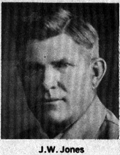
Picture #1 – The model “C” Touring Car had a wheel base of 108 inches and was priced at $675.
Picture #2 – The model “B-16” Roadster had a wheel base of 102 inches and was priced at $615.
Picture #3 – The Model “F” Coupe had a wheel base of 102 inches and was priced at $825.
Picture #4 (missing) – A building on South Poplar Street where cars were built. It was pre- viously a lamp factory.
Picture #5 (missing) – Ira Cadwallader
Picture #6 (missing) – Lester Cadwallader
Picture #7 – Charles Ash
Picture #8 – J.W. Jones
The Fostoria Light Car Co. later to be known as Seneca Motor Car Co., will be remembered by residents who lived here 65 to 75 years ago, but to scores of readers who settled here later, it will be revealed that it was a manufacturer of automobiles that were produced right here in Fostoria.
When Henry Ford started making his horseless carriage at the turn of the century, and brought out the first model “A” in 1903, it signaled the steady de- cline for the horse and buggy. It was also an era when many car manufacturers came into existence.
Many promoters and financiers were aware of the new trend and the opportunity to establish a new type of manufacturing and Fostorians were no exception.
According to historical data, a Mr. George approached J.H. Jones, a local con- tractor, expressing an interest in getting into the automobile business. The man’s first name and from whence he came, seems to be lost in antiquity, and although he planted the seed, his name was never again mentioned in the re- cords which I examined.
COMPANY STARTED 1915
The idea planted in Jones’ mind was so strong that he in turn presented it to Charles Ash, local banker; Ira Cadwallader, industrialist; and Roy Ridgeway, who was associated with The Storm Buggy Co., and also Seneca Lamp Co. Photos of only three of the original group could be found, plus Lester Cadwallader who joined the firm later.
In 1915, that group organized The Fostoria Light Car Co., and set up operations in the brick building on South Poplar Street, where the railroad crosses …Fourth Street is close by. The building was already in existence, having been used previously for the production of Fostoria incandescent light bulbs, during the days of the flourishing glass industry. The Fostoria Incandescent Co. was sold to General Electric and moved to Cleveland.
The first automobiles made by the new company was an assembly of purchased parts. The motors were supplied by Sterling Motors, Milwaukee, and turned out to be so poorly built that by the time 2,000 cars had been completed in a period of two years, the company was forced into receivership. It was im- possible to sell the cars because of the poor quality.
Later, Leroi motors were used which proved highly satisfactory, but plans and promises failed to materialize, and again the company failed. The factory was still full of machinery, tools, parts and the Sterling Motors from the earlier adventure still on hand.
CADWALLADER SAVED COMPANY
At this point, J.H. Jones approached Lester Cadwallader, son of Ira, one of the original stockholders, to see if he would undertake to salvage the business for which there had been great dreams. Jones reasoned that Lester was the right man, since he was interested and knew about cars. He was one of those first in Fostoria to own a car, and a 1911 Owens was owned by the Cadwalladers.
It must have been a challenge to Lester, and he probably reasoned that Henry Rod had tried and failed on more than one occasion to establish a business, so he agreed to accept the job.
First of all, Judge C.L. Guernsey made a settlement for the bankrupt company, permitting it to resume manufacturing. And, the name of the company was changed to Seneca Motor Co. They were now ready to make a new try.
The defective Sterling Motors were returned for correction and rebuilding, and a new contract was made with Leroi Motors.
Because the operation for the cars was not good locally, Les had to establish a market. An an in Popular Mechanics magazine brought enough business, including exporters, which soon accounted for 80 percent of their production, amounting to three to five cars daily. The new models were shipped to nearly every country on Earth. All exported cars had to have right-hand drives.
BIRCH BOOSTED SALES
At that time, Birchard of Chicago was a correspondence school, teaching potential car buyers how to drive and maintain cars. The school offered graduates the opportunity to buy cars through the Birchard Motor Car Co. at reduced prices. The cars sold that way had to carry the name BIRCH for Seneca. That was an easy decision for Lester to make. That arrangement continued from 1916 to 1923, and boosted business considerably.
Birchard grads who lived in this area accepted delivery at the factory, and according to history many came to town to drive their cars home. However, many of them had never driven a car and told Les that. The story goes that Lester would remind them that they were graduates of the Birchard school and would place them in the driver’s seat..he beside them. Leaving the factory on South Poplar, he would stay with them until they crossed the railroad tracks and had proceeded a few blocks, when he would tell them, “you’re doing great, you don’t need me any longer.”
BUSINESS GOOD BY 1918
By 1918, Lester Cadwallader had the company “humming,” and cars were sold as fast as they could be built. It got to the point Lester couldn’t keep on top of everything…managing, selling, buying, records, etc., so in 1919, Frank Blazer joined the company as general manager.
Les then became sales manager. Also at that time the staff expanded. J.L. Cleveland, an engineer formerly with Allen Motor Co., another Fostoria car manufacturer, became engineer; others were, Charles Degan, factory superintendent; Pat Patterson, bodies; Kenneth Strouse, chief road tester; Ed Kurtz, purchasing agent.
Patterson managed The Globe Body Co., on South Union Street, where one of the Atlas Crankshaft plants is now, and it was in that building that the roadster and touring car bodies were made for Seneca’s cars.
By that time, 1918, Seneca cars were equipped with Autolite ignition and starters, Bendix drive, Prestolite batteries. Later Lycoming motors were used. The revitalized company was turning out quality cars, as illustrated in accompanying photos.
However, in 1922, new signs of trouble appeared for the company. It was get- ting difficult to acquire parts with the advent of more car manufacturers. Also, closed cars were being offered, and Fischer Brothers and Briggs had most of the skilled body workers and know-how.
Seneca Motor Car Co. continued until 1924, when they stopped production. However, for many years afterward, they continued to ship replacement parts from their stock, many of them going to foreign countries.
REMEMBER?
Pat Patterson was the same “Pat” who was a Rotarian and active in the local club’s crippled children program. A number of local children were benefitted by that activity and they will recall him. He also worked for the Nickle Plate Railroad in later years.
Charles Deagan, after the demise of Seneca, became a popular car mechanic, with a large following of customers because of his knowledge of cars.
J.L. Cleveland will be remembered by both baseball players and fans locally as an umpire for industrial leagues. They will also recall his son Don, an FHS football player, and daughter Helen, who married “Willy” Lehman, once secretary of the local YMCA.
Ira “Ike” Cadwallader, son of Lester resides in Fostoria, but doesn’t have a leftover car from Seneca to exhibit.
Ed Kurtz was a captain in the Army during World War I, and Mayor of Fostoria from 1922-26.
J.H. Jones built the Union National Bank (now Tri-County), also several of Fostoria’s reservoirs. He lived on North Main Street. Paul Jones, son, continued with his father’s business until his death. None of the Jones family now lives in Fostoria.
Frank Blaser, in later years had Phoenix Coal Co., the location was near the N & W tracks where the underpass is now (overhead) near South Wood Street. Blaser was also city service director in the Cliff Shuman administration.
Many years ago, I recall a story that was often retold locally about the Seneca cars: It was supposed to have established a record for a run up Pikes Peak, the famous Colorado mountain which many readers know about.
Bill Murphy, a restored-car enthusiast knows of no Seneca Motor cars in this area.
Gregg Smith, 1224 Sandusky St., owned a Seneca tire cover until about a year ago, but finally sold it to Harrah’s Automobile Collection, owner of the Seneca car living in Reno, Nev. The car, a 1919 model, has never been re- stored. (Perhaps more another time).